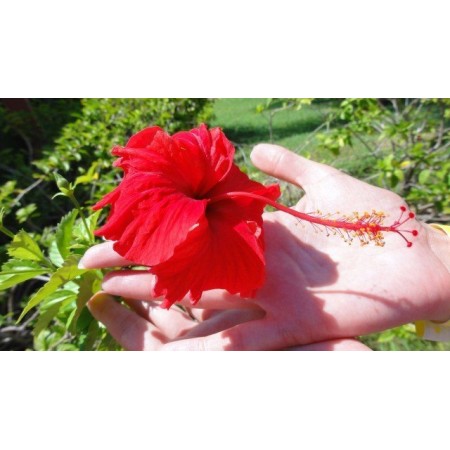Growing and domestic use of Sudanese roses

Sudanese rose is often called "hibiscus" - a healing flower originally from Sudan, where it has long been used in everyday life by experienced gardeners. Also, this representative of the flora grows in China, Thailand and India, and its dried leaves have recently been imported into Russia as a natural remedy for many common problems and diseases. In this article we will talk about how Sudanese rose is used and what effect is obtained when a specific drink is consumed.
Flower application
Most often, sour-sweet tea is prepared from the petals of Sudanese rose, which can be safely consumed both in hot and in cold form. However, not only tea can be prepared from hibiscus, but also compote, jam and jam - it is equally useful in any form. Stems and shoots also find their place in many exotic salads, seasonings for first courses and vegetables.
Even in ancient Egypt, Queen Cleopatra herself ate hibiscus and even took baths with the addition of leaves of this flower. The then medical experts believed that the beneficial properties of the plant favorably affect not only the well-being of the ruler, but also maintain skin elasticity and youthfulness for a long time.
Currently, healers who prefer to use natural healing substances in practice, argue that the Sudanese rose helps to solve the following problems:
- Removing problem areas on the skin - soaked petals are used as a mask;
- Removing edema under the eyes due to too exhausting rhythm of life - in such cases, tea leaves are used in the form of gauze bags diluted in hot water;
- Getting rid of oily hair - gruel from hibiscus is rubbed into the scalp, which prevents the secretion of sebum.
Of course, the Sudanese rose can also be used as a simple interior decoration, but why deprive yourself of the many beneficial effects of the plant?
How to grow hibiscus at home
If you decide to grow Sudanese rose at home, then you should provide a suitable temperature regime for the pot, water it stably and protect it from drafts. Direct sunlight also has a detrimental effect on the plant - burns appear on the leaves, and they can hardly be used for medicinal purposes in the future.
The first signs of problems with the plant are the appearance of dried parts on the leaves. In such cases, they should be carefully cut and revised their attitude to watering and spraying the roses.
The rose should be fed actively during its growth, introducing liquid bacterial fertilizers into the soil. In general, in practice, you just need to follow the rules indicated on the package with seeds - caring for such a plant is not difficult or irrational.